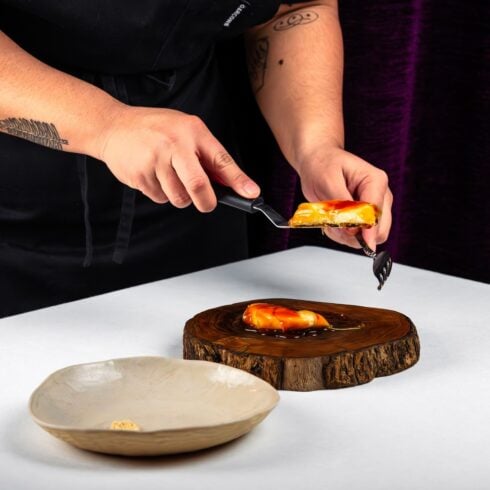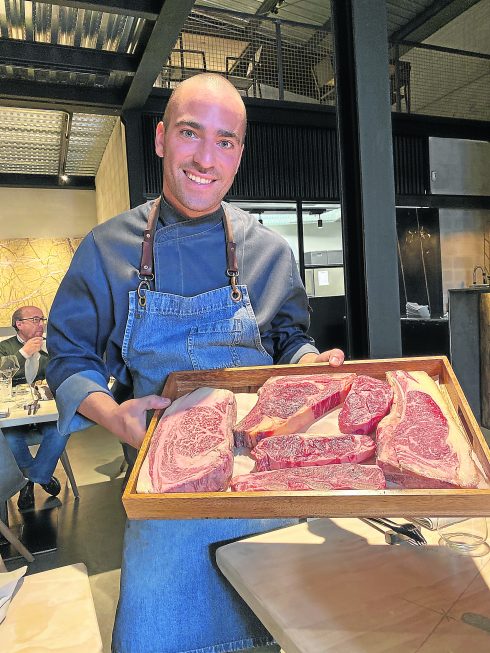WITHOUT a doubt one of Spain’s genuine world-leading gourmet delights is Cerdo Iberico – the pork from the black Iberian Pig.
What makes this meat so incredibly special is that for the last few months of each pig’s life, they are allowed to graze free-range in dehesas (acorn forests), munching their way through literally tons of bellotas (acorns), which have fallen from both holm and cork oak trees.
It is these acorns which gives the fat of the pigs its unique, sweet flavour, whether you are eating the ham or cooked pork.

Take a look at the pork in its raw state and you will notice how the meat is shot through with streaks of creamy white fat.
Best of all, this fat dissolves during the cooking process, flavouring the meat and making it perfectly tender.
The happy Iberican pig can only be bred in a few parts of the Spain and nowhere else in the world does it get its unique flavour.
In Spain this region stretches from as far south as the Aracena region, around Jabugo – the jamon capital of Spain – and then up into the far north of the Salamanca region.
With oak forests becoming increasingly endangered and shrinking each year, it is a finite production becoming more in demand each year, particularly since the US finally allowed its import in 2007.
These hams are often described as ‘the most expensive’ in the world and the highest quality can sell for thousands of euros a leg.

The acorns are the key to the quality of the meat, not just in the way they sweeten the fat.
The acorns make the pigs thirsty, forcing them to run around looking for water and making them more athletic, developing fine bones which are evident in a leg of Jamon Iberico.
When I first came to live in Spain, my Spanish friends would tut, tut when I pulled the fat off a slice of ham (also refered to as Pata Negra because of the pigs’ black hooves) and cast it aside.
Most Spanish regard this fat as a delicacy and I now tend to agree. Its sweetness literally melts in your mouth. Wrapped around a tiny break stick (pico), followed by a sip of Fino sherry, it is simply divine.
Breeding these pigs is no cheap task – it is literally at the opposite end of the spectrum of normal intensive pig farming. This is obviously reflected in the price.
The most expensive and best quality is called jamon iberico de bellota (acorn).
This ham comes from pigs, who have lived free-range all their lives, dining almost entirely on acorns. The more exercise these pigs get, the more the fat blends into their muscles and the tastier the meat becomes. It is considered that 5J (cinco jotas), is the King of jamon bellota.
The next grade is called jamón ibérico de recebo. This ham is from pigs that are both pasture and compound fed a combination of acorns and grain.
The third type is called jamon iberico de pienso, or simply, jamon iberico. This ham is from Iberian pigs that are solely compound fed on grain and some acorns.
The term pata negra is also used to refer to jamon iberico in general and may refer to any one of the above three types.
It is important to note that jamón serrano comes from Cerdo Blanco (the more common white pigs) that is solely grain fed.
This comprises around 90 per cent of the pork and ham production in Spain. This is the cheapest of the jamons. It’s still delicious and perfect for sandwiches or cooking should your recipe call for jamon.
Another important thing to understand – in terms of price and quality – is which leg you are buying. A jamon iberico is normally the hind leg of the pig. A paletilla is the front leg.
Nevertheless, a paletilla can have an excellent taste and undergoes the same processes of ham-making. The difference is that a paletilla is smaller and has more fat. Therefore it’s cheaper.
So if you’re considering buying a ham, but can’t afford a Jamon Ibérico de Bellota, ask for a Paletilla Iberico de Bellota, it is usually less than half the price.
READ MORE:
- FOOD FIGHT FRENZY: Spain’s foody wars from Els Enfarinats in Alicante to la Tomatina in Valencia’s Buñol
- Calling all adventurers: ‘Zarajos’ and ‘entresijos’ – tried the weird Spanish food from Madrid?
Click here to read more Food & Drink News from The Olive Press.








